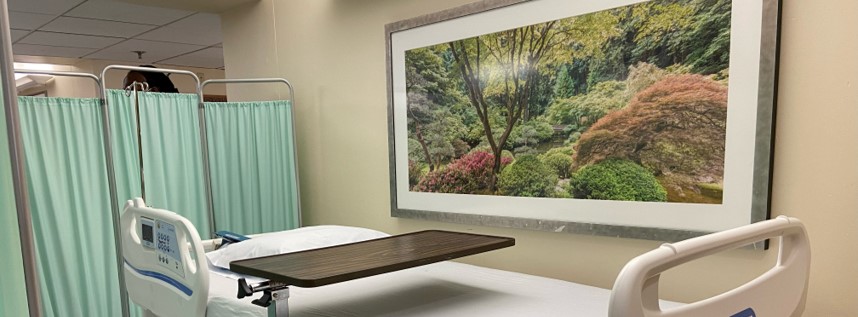
A temporary bed in the hallway at BWFH
In Boston and across the country, Emergency Departments continue to see record high volume. To ensure every patient who comes through our doors gets the care they need when they need it, Brigham and Women’s Faulkner Hospital has implemented a new workflow designed to move patients waiting to be admitted to the hospital up to an inpatient unit faster to free up space in the ED.
“Like every ED in the Mass General Brigham system, we use standard capacity status definitions to help us manage our work,” says ED Nurse Director Robin Powell, MSN, RN, CEN. “As patient volume grows, we move from ‘Normal Operations’ to ‘Pre-Code Help’ to ‘Code Help’ and finally to ‘Capacity Disaster.’ Capacity Disaster is when we have more patients in the ED than we have space. Typically, those patients are what we call ‘boarders.’ They are patients who have been evaluated and we have determined they need to be admitted to the hospital, but a bed is not yet available on the inpatient unit for them, so they remain in our care while they wait.”
In order to make room for incoming patients who need emergency care during a Capacity Disaster, a group at BWFH came together to create a plan. “We needed to find space to safely care for these patients outside of the ED,” says Associate Chief Nurse of Inpatient Nursing Lynne Morrison, MS, RN. “We established a Code Surge Committee that identified hallway space on the inpatient units where up to 16 temporary beds could be set up. We then pulled in key stakeholders from the various disciplines to ensure those spaces would be appropriate for patients, while at the same time providing caregivers with the tools they need to provide care in a non-traditional space.”
Under the new workflow, when Capacity Disaster is confirmed, the team in the ED evaluates their current patient population and identifies those patients who are waiting for a bed on an inpatient unit and are well enough to be safely cared for in a temporary hallway bed. Among the patients who qualify are those that can wear a surgical mask continuously, can use a shared bathroom and require no isolation or suction, among other requirements.
When a patient is moved from the ED to a temporary hallway bed on an inpatient unit, they are transferred to the care of their inpatient nurse. In the temporary hallway space, the nurse has everything needed to care for that patient and the patient has what they need to be comfortable, including a bedside table and call bell.
“Both our ED and inpatient nurses have been trained how best to explain the situation to patients. We hope that our patients will be much more comfortable away from the busy ED and feel better knowing the ED staff now has more space to care for more patients,” says Powell.
“Caring for patients in hallways should never be considered the norm,” adds Morrison. “But if it means we are able to care for everyone who needs us, we are happy to think of creative ways to make it happen.”
Published 6/29/22
Looking for more news from BWFH? Go to News to find articles about health, updates to our programs and services and stories about staff and patients.
Go to News